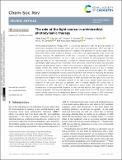Files in this item
The role of the light source in antimicrobial photodynamic therapy
Item metadata
| dc.contributor.author | Piksa, Marta | |
| dc.contributor.author | Lian, Cheng | |
| dc.contributor.author | Samuel, Imogen C. | |
| dc.contributor.author | Pawlik, Krzysztof J. | |
| dc.contributor.author | Samuel, Ifor D. W. | |
| dc.contributor.author | Matczyszyn, Katarzyna | |
| dc.date.accessioned | 2023-02-14T10:30:05Z | |
| dc.date.available | 2023-02-14T10:30:05Z | |
| dc.date.issued | 2023-03-07 | |
| dc.identifier | 283356844 | |
| dc.identifier | 6039a6b6-8551-4a71-9bf4-e5f29a8d8422 | |
| dc.identifier | 85148677703 | |
| dc.identifier.citation | Piksa , M , Lian , C , Samuel , I C , Pawlik , K J , Samuel , I D W & Matczyszyn , K 2023 , ' The role of the light source in antimicrobial photodynamic therapy ' , Chemical Society Reviews , vol. 52 , no. 5 , pp. 1697-1722 . https://doi.org/10.1039/D0CS01051K | en |
| dc.identifier.issn | 0306-0012 | |
| dc.identifier.other | RIS: urn:CCF4EFD61BC6CF02C5E8F260BEA9DB4E | |
| dc.identifier.uri | https://hdl.handle.net/10023/26974 | |
| dc.description | Funding: This work was financially supported by the European Union's Horizon 2020 research and innovation programme under the Marie Sklodowska-Curie grant (agreement no. 764837) and NCN Opus grant no. 2019/35/B/ST4/03280. We are also grateful to the Engineering and Physical Sciences Research Council of the UK for financial support from grants EP/R511778/1 and EP/L015110/1. | en |
| dc.description.abstract | Antimicrobial photodynamic therapy (APDT) is a promising approach to fight the growing problem of antimicrobial resistance that threatens health care, food security and agriculture. APDT uses light to excite a light-activated chemical (photosensitiser), leading to the generation of reactive oxygen species (ROS). Many APDT studies confirm its efficacy in vitro and in vivo against bacteria, fungi, viruses and parasites. However, the development of the field is focused on exploring potential targets and developing new photosensitisers. The role of light, a crucial element for ROS production, has been neglected. What are the main parameters essential for effective photosensitiser activation? Does an optimal light radiant exposure exist? And finally, which light source is best? Many reports have described the promising antibacterial effects of APDT in vitro, however, its application in vivo, especially in clinical settings remains very limited. The restricted availability may partially be due to a lack of standard conditions or protocols, arising from the diversity of selected photosensitising agents (PS), variable testing conditions including light sources used for PS activation and methods of measuring anti-bacterial activity and their effectiveness in treating bacterial infections. We thus sought to systematically review and examine the evidence from existing studies on APDT associated with the light source used. We show how the reduction of pathogens depends on the light source applied, radiant exposure and irradiance of light used, and type of pathogen, and so critically appraise the current state of development of APDT and areas to be addressed in future studies. We anticipate that further standardisation of the experimental conditions will help the field advance, and suggest key optical and biological parameters that should be reported in all APDT studies. More in vivo and clinical studies are needed and are expected to be facilitated by advances in light sources, leading to APDT becoming a sustainable, alternative therapeutic option for bacterial and other microbial infections in the future. | |
| dc.format.extent | 26 | |
| dc.format.extent | 4318670 | |
| dc.language.iso | eng | |
| dc.relation.ispartof | Chemical Society Reviews | en |
| dc.subject | QD Chemistry | en |
| dc.subject | QR Microbiology | en |
| dc.subject | RM Therapeutics. Pharmacology | en |
| dc.subject | T-NDAS | en |
| dc.subject | SDG 2 - Zero Hunger | en |
| dc.subject | AC | en |
| dc.subject | MCC | en |
| dc.subject.lcc | QD | en |
| dc.subject.lcc | QR | en |
| dc.subject.lcc | RM | en |
| dc.title | The role of the light source in antimicrobial photodynamic therapy | en |
| dc.type | Journal article | en |
| dc.contributor.sponsor | EPSRC | en |
| dc.contributor.sponsor | EPSRC | en |
| dc.contributor.institution | University of St Andrews. School of Physics and Astronomy | en |
| dc.contributor.institution | University of St Andrews. Centre for Biophotonics | en |
| dc.contributor.institution | University of St Andrews. Condensed Matter Physics | en |
| dc.identifier.doi | https://doi.org/10.1039/D0CS01051K | |
| dc.description.status | Peer reviewed | en |
| dc.identifier.grantnumber | EP/R511778/1 | en |
| dc.identifier.grantnumber | EP/L015110/1 | en |
This item appears in the following Collection(s)
Items in the St Andrews Research Repository are protected by copyright, with all rights reserved, unless otherwise indicated.

